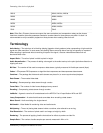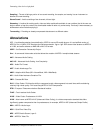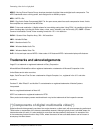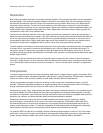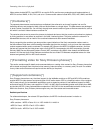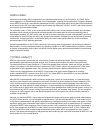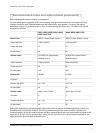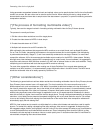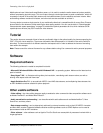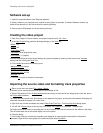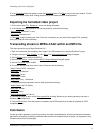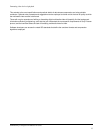
Formatting video for local playback
Generated by Clearspace on 2008-05-18-05:00
9
Using parameters somewhere between the basic and optimal values can be practical when the file size of multimedia
content is a concern. Bit rate values can be used to control file size. When reducing bit rate by a large extent it is
also advised to scale the frame rate or sample rate of the data stream in proportion, to prevent introducing excessive
compression artefacts.
{*}The process of formatting multimedia video{*}
Typically, there are four stages involved in formatting existing multimedia video for Sony Ericsson phones.
The process is normally as follows:
1. Edit the various video resolutions to suit the target phone.
2. Encode the video stream to MPEG-4 visual simple.
3. Encode the audio stream to LC-AAC.
4. Multiplex both streams into an MP4 container file.
With multimedia video software that supports the MP4 container as an output format, such as Apple Quicktime
Pro or Final Cut Studio, transcoding both streams to the required codecs can be done together, and multiplexing
is performed automatically. Stages 2, 3, and 4 are essentially condensed to one stage. However, for most video
composition software, AVI is the recommended available output container for the MPEG-4 video stream. Similarly
although some video software supports AAC compression as an output format, for most software it is suggested to
export the audio stream to WAV and then encode to LC-AAC with an external codec or other audio software. Finally
multiplexing can be achieved with tools that support MP4 container authoring.
For most video composition software, when making use of Apple Quicktime Pro to encode data streams and
multiplex to an MP4 container, it is recommended to output multimedia video in the MOV format. The MOV format
allows the multimedia video to be easily opened by Quicktime Pro.
{*}Other considerations{*}
The following is general advice to achieve better results when formatting multimedia video for Sony Ericsson phones.
Sony Ericsson phone screens have a 4:3 aspect ratio. The visual resolution of the source media may be of a
different aspect ratio, such as widescreen 16:9. Whilst it is possible to add black borders to the top and bottom of
the video to preserve the aspect ratio, due to the limited size of mobile phone screens it is recommended to instead
crop pixels from the sides of the video so it becomes 4:3 aspect. Most media content is designed to permit this
without losing significant areas of the image, for applications such as 4:3 aspect television broadcasts.It is best to
start with sources of a higher visual resolution than the target phone. Through intelligent downsampling to the phone
resolution, a lot of detail can be preserved compared to beginning with a low visual resolution source. It is advised
to use an anti-aliasing filter when resizing the visual resolution of the media. Most video composition software will
automatically apply the anti-aliasing filter.
MPEG-4 visual codecs tend to smooth out visible details in a video at the bitrates and resolutions used for mobile
phones. To combat this, adding a sharpening filter after resizing a video source is suggested. A sharpening filter
will exaggerate edges, details, and highlights, and this 'hinting' of the video causes the codec to pay closer attention
to such subtle details that would otherwise be smoothed out. Use of sharpening filters should be judicial, as they
increase the bit rate required to encode a video to a certain quality level. In situations where there is insufficient bit
rate available, sharpening filters should be avoided.




